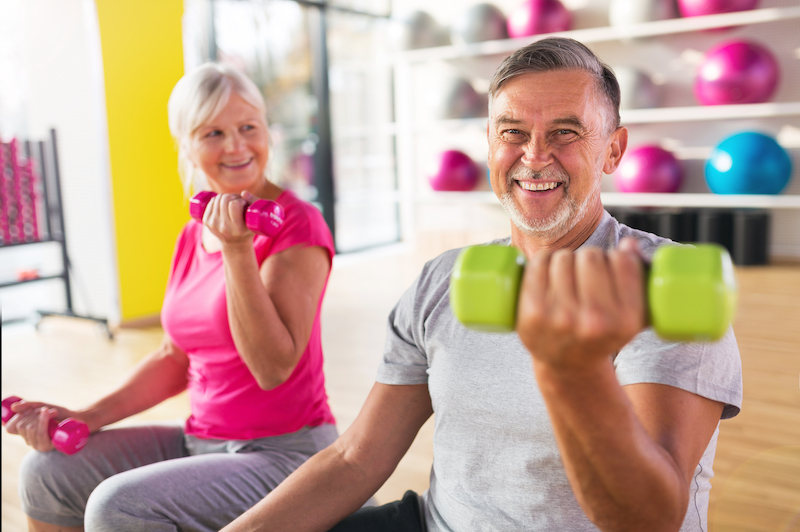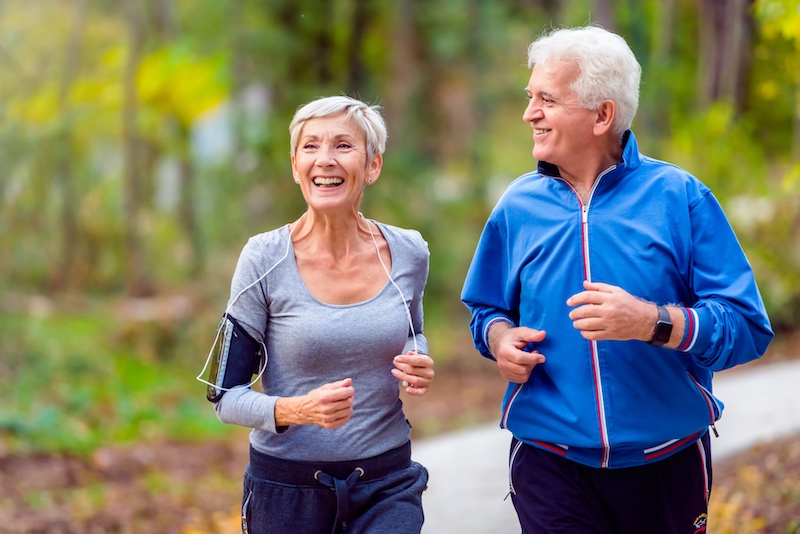Fitness for seniors is an essential component of maintaining overall health and well-being as we age. Regular physical activity can not only keep older adults active but also enhance their independence and quality of life. This post will take a look at the value of physical activity for elderly people and cover various kinds of exercise that are tailored to their particular needs.
From boosting energy levels through physical activities to protecting the heart with cardiovascular exercises, there are numerous benefits associated with staying active during our golden years. We’ll delve into daily routines that promote active aging and provide tips on how to safely prepare for senior fitness regimens.
Lastly, we will address the detriments of not exercising for older individuals and highlight some fitness options available at Boynton Beach assisted living facilities, including tailored programs designed specifically with seniors’ needs in mind. By understanding the significance of fitness for seniors and incorporating appropriate exercises into your routine or that of a loved one, you can greatly improve overall health outcomes while enjoying a more fulfilling lifestyle.
Table of Contents:
- The Importance of Exercise for Seniors
- Four Types of Exercises for Senior Fitness Routines
- Detriments of Not Exercising for Seniors
- Precautions Before Starting a New Fitness Regimen for Seniors
- Fitness Options at Assisted Living Facilities
- FAQs in Relation to Fitness for Seniors
- Conclusion
The Importance of Exercise for Seniors
Regular exercise is crucial for seniors as it offers numerous benefits, including boosting energy levels, maintaining independence, and protecting the heart.
Boosting Energy Levels
Exercise improves circulation, which leads to increased alertness and reduced fatigue, making daily tasks easier for older people.
Maintaining Independence
An active lifestyle promotes mobility by strengthening muscles that support joints, reducing risk factors associated with falls.
Protecting the Heart
- Moderate-intensity exercises are suitable for those with chronic conditions such as heart disease.
- Vigorous exercises increase endurance capacity while reducing risks related to cardiovascular issues.
- Tai chi has been found effective in lowering blood pressure among elderly participants.
By incorporating a well-rounded exercise routine that includes strength training, older adults can reduce their risk of developing chronic conditions and improve overall heart health.
Engaging in routine physical exertion can assist with managing the indications of sickness or torment, for example, those brought about by joint inflammation or diabetes; thusly making it a fundamental piece of keeping up a sound way of life. So, get moving.
Four Types of Exercises for Senior Fitness Routines
There are four types of exercises that should be incorporated into a senior’s fitness routine: endurance (cardio), flexibility, balance, and strength training.

- Endurance (cardio): Activities like swimming or dancing provide low-impact options for improving cardiovascular health.
- Flexibility: Incorporating yoga or tai chi into an exercise routine helps keep muscles flexible and joints mobile.
- Balance: Practicing standing on one foot or using a stability ball can help prevent falls by improving coordination and body awareness.
- Strength training: Lifting weights or engaging in resistance band workouts strengthens the large muscle groups necessary for maintaining independence.
Seniors aged 65 and older should strive to engage in a weekly routine of 2.5 hours of moderate aerobic exercise, as well as 1 hour and 15 minutes of vigorous physical activities, for optimal health benefits.
For further details regarding exercise regimens for the elderly, look into the National Council on Aging.
Detriments of Not Exercising for Seniors
Skipping physical activities during old age can lead to chronic illnesses like heart disease, depression, and anxiety, reducing one’s ability to remain independent and negatively impacting one’s overall quality of life. As such, fitness for seniors is imperative.
Increased Risk of Chronic Illnesses
Physical activities are essential for seniors to reduce the risk of chronic conditions such as diabetes, heart disease, and osteoporosis by improving blood circulation and managing weight.
Mental Health Decline
Regular physical activity can help seniors to boost their mood and reduce stress levels by releasing endorphins.
Tips on How Older Adults Can Stay Active:
- Brisk walking: Engage in moderate-intensity exercises like brisk walking around the neighborhood or at your local park.
- Lifting weights: Maintain muscle mass while improving balance and coordination skills needed for everyday tasks through strength training with light weights.
- Tai chi classes: Join a class at your local YMCA or community center to benefit from the low-impact nature of tai chi.
- Water aerobics: Seniors with limited mobility or chronic pain can opt for gentle water-based exercises like water aerobics that are easy on the joints.
Precautions Before Starting a New Fitness Regimen for Seniors
Safety first. Before beginning a new fitness regimen, seniors should seek medical advice to ensure safety and avoid any potential complications related to pre-existing conditions or limited mobility.

Consulting with Healthcare Professionals
Get the green light from your healthcare provider before starting any exercise routine, especially if you have chronic conditions like heart disease or diabetes. They can provide guidance on which exercises are safe and suitable based on individual needs.
Selecting Appropriate Attire and Footwear
Prevent injuries by choosing comfortable clothing that allows freedom of movement and proper footwear designed for older people’s feet to support balance and minimize discomfort from common foot problems like arthritis or bunions.
The Importance of Warming Up and Cooling Down
- Warming up: Start each workout session by warming up your muscles through light aerobic exercises like brisk walking or gentle stretching to increase blood flow and prepare joints for more intense movements later in the routine.
- Cooling down: After exercising, gradually reduce the intensity of physical activity and incorporate gentle stretches to allow the heart rate to return to normal levels and prevent muscle stiffness or soreness.
By taking these precautions, older individuals can gain the numerous advantages of frequent physical activity, such as augmenting strength and equilibrium, increasing muscle mass, lessening the potential for chronic issues, and boosting general well-being.
Fitness Options at Assisted Living Facilities
Assisted living facilities offer tailored fitness options for seniors, including everything from fitness classes and golf to yoga.
Sports Classes
Low-impact sports classes like bocce ball or shuffleboard improve strength, balance, and coordination while promoting social interaction.
Water Aerobics
Indoor pools provide low-impact water aerobics classes that reduce stress on joints and build muscle mass.
Yoga and Tai Chi
- Yoga: Gentle yoga poses and deep breathing techniques improve flexibility, balance, and relaxation.
- Tai Chi: Slow movements and deep breathing promote muscle strength, flexibility, and coordination.
FAQs in Relation to Fitness for Seniors
Why is physical fitness important for seniors?
Fitness for seniors helps them maintain independence, reduce the risk of chronic conditions, and improve overall quality of life.
What is fitness advice for seniors?
Seniors should engage in a mix of endurance/cardio workouts, flexibility routines, balance-focused activities, and strength training sessions that work on large muscle groups.
What is the most important fitness component in older adults?
Balance exercises are crucial for older adults as they help prevent falls and injuries by improving stability.
What exercise should a person over 70 years old be doing?
A 70-year-old should focus on low-impact activities that promote cardiovascular health, strength training with light weights or resistance bands, flexibility exercises, and balance-enhancing movements.
Conclusion
Senior fitness is crucial for maintaining good health and independence, and incorporating physical activity into daily routines can prevent chronic illnesses and boost energy levels.
When considering fitness for seniors, endurance/cardio workouts, flexibility routines, balance-focused activities, and strength training sessions are the four types of exercises that should be included in the regimens, and daily activities like gardening and taking stairs can also promote mobility and increase leg strength.
It’s important to consult a healthcare professional and wear appropriate workout attire while warming up and cooling down before exercising to prepare safely for senior fitness regimens, as not exercising can lead to an increased risk of chronic illness and muscle loss, which can reduce mobility.
Assisted living facilities offer tailored fitness programs designed with seniors’ needs in mind, and by incorporating exercise into their lives through various methods, seniors can maintain their independence longer while enjoying better overall health.
Looking for an assisted living facility in Boynton Beach, Florida? Look no further than Courtyard Gardens. Not only do they offer a host of fitness options, but dining that will help seniors meet their nutritional needs, culture and educational programs, and even specialty memory care.


